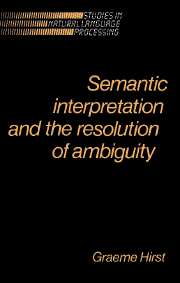6 - Structural disambiguation
Published online by Cambridge University Press: 18 December 2009
Summary
Introduction
In this chapter, I discuss the problem of syntactic, or structural, disambiguation, which was first introduced in section 1.1.3. I will provide the background for the discussion in chapter 7 of the Semantic Enquiry Desk, a structural disambiguator that works with Absity and Polaroid Words.
Types of structural ambiguity
Structural disambiguation is necessary whenever a sentence has more than one possible parse. There are many classes of structurally ambiguous sentence; below I show some of the more common, but do not attempt to produce an exhaustive list. Included in the list are some local ambiguities (see section 1.1.3) that people can be garden-pathed by.
I will use two methods of demonstrating structural ambiguity. In some cases, I will give one sentence and show its several parses; in others, I will give two sentences such that each has a different preferred parse but each could clearly also have the structure of the other. For simplicity, when I show a parse, I will often show it only for the part of the sentence that contains the ambiguity; pseudoprepositions (see section 3.4) are not usually inserted, except where necessary to make a point.
Attachment problems
The first class of structural ambiguity is that of ATTACHMENT AMBIGUITY: there being more than one node to which a particular syntactic constituent may legally be attached. Attachment problems are mostly problems of MODIFIER PLACEMENT. The most common example is that of a prepositional phrase that may either modify a verb (i.e., be a case-slot filler) or an immediately preceding noun phrase. For example:
(6-1) Ross wanted to phone the man with the limp.
(6-2) Ross wanted to wash the dog with Hoary MarmotTM brand pet shampoo.
- Type
- Chapter
- Information
- Semantic Interpretation and the Resolution of Ambiguity , pp. 131 - 163Publisher: Cambridge University PressPrint publication year: 1987

